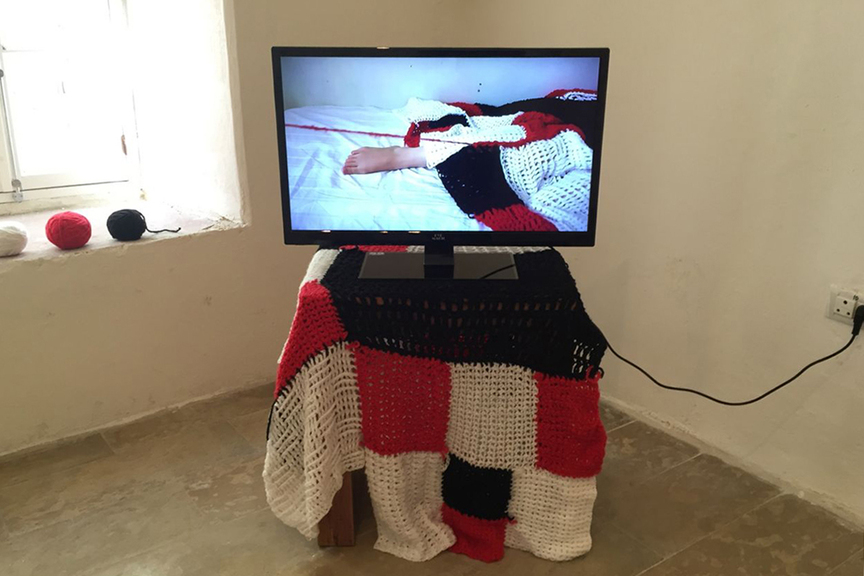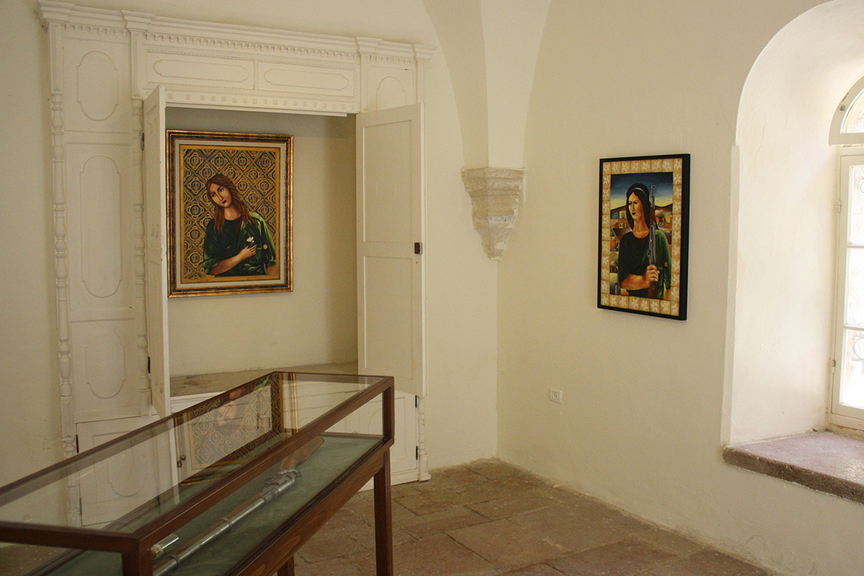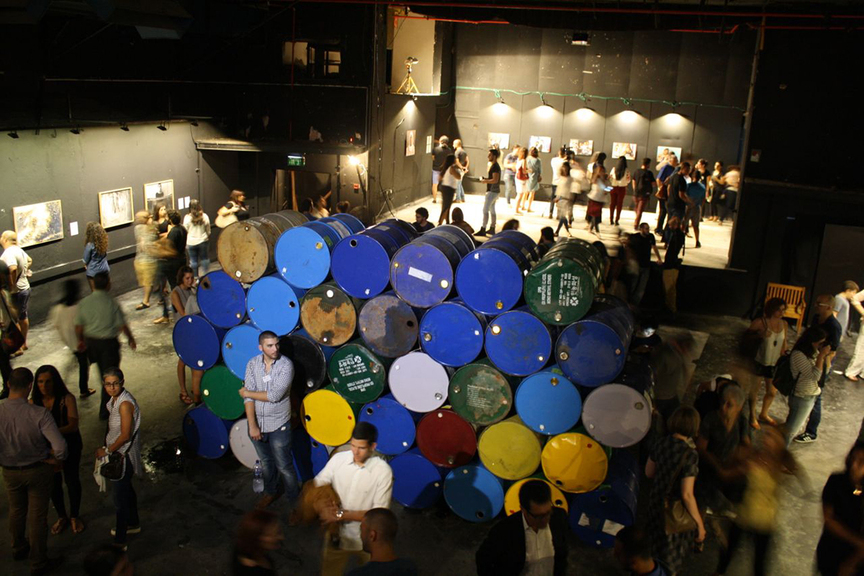
R
E
V N
E
X
T
The hilltop of Ramallah’s Old City, with signs of the city’s housing boom. All photos by HG Masters for ArtAsiaPacific, unless otherwise stated.
This the second part of a series about Qalandiya International 3, which was held at sites across Palestine and abroad. Read Part 1 here.
Day 2: Location Matters
The first full day in Ramallah had ended with a glimpse of young professional life in the city through the stories of Amer and Mohamad, and hearing about their genuine excitement about art as an alternative arena to do something new or different, and to question all the roles and existing hierarchies. At the beginning of the second day, curator Nat Muller gave us a closer look at the biennial AM Qattan Foundation’s Young Artists of the Year Award (YAYA) exhibition, which opened up another wide spectrum of experiences and concerns among young Palestinians living in a range of socio-economic circumstances.
Now in its ninth edition, the YAYA competition is eligible for Palestinian artists between the ages of 22 and 30, regardless of where they live. Past participants have included artists from several generations, from Jawad al-Malhi, Rosalind Nashashibi and Steve Sabella, to more recent nominees Shadi Habib Allah, Shuruq Harb and Jumana Manna—among many others—so the award that has accrued an interesting history in helping artists launch their careers. The 2016 YAYA exhibition was installed in Beit Saa, a beautifully restored home in Ramallah’s old city, and was titled “Pattern Recognition,” after the artists’ interest in what Muller described as seeking out “patterns that define the unruliness of our present condition.”
MAJDAL NATEEL, Dream Is Possible (2016), gypsum and earth, dimensions variable. Installed at the Young Artist of the Year 2016 (YAYA), Ramallah, during Qalandiya International 3.
The artist’s circumstances were unavoidably evident. Majdal Nateel, for instance, lives in Gaza and thus couldn’t travel to Ramallah to create or install her sculpture Dream Is Possible (2016), a series of 26 pillows created from a gypsum mold and filled with earth, which spilled out onto the gray plinth. At first, I mistakenly thought these pillows were sand bags, an image that comes with all the connotations in its context of Gaza. Somar Sallam faces similarly adverse circumstances. She and her family are Palestinian refugees who lived in Syria—she was born and studied art in Damascus—before they were displaced for a second time, ending up in rural Algeria. Sallam’s video Disillusioned Construction (2016) was the first she had ever produced and it depicted her crocheting (and unwinding) a patchwork woolen blanket of white, red and black, and recording the different forms the blanket took on when draped over her body. Asma Ghanem was also born in Damascus though her family returned to Palestine in 1993 after the Oslo Accords. Her sound piece, Homeland Is . . . (2016), was represented by a visual score in the gallery—we would hear a live performance of it later in the week. It was, along with Abdallah Awwad’s pair of iron and wire sculptures draped in plaster cobwebs, The Horizon’s Pathway (2016), one of the few attempts we would come across during our trip that rendered artistic concerns in an abstract language.
The existing reality of Palestine plainly offers artists more than enough material to work with. Jerusalemite Aya Kirresh, for instance, decided to bore through the city’s history by investigating the mortar mixtures used over the centuries in her project A Concrete Ode to History (2016), forming self-curing piles (shown on metal plinths) and a tubular form that looked like a geologist’s core sample and served as a timeline for the city’s history. Interestingly, on Kirresh’s chromatic timeline, the mortar mixtures were reddish to yellow up until the Nakba (1948), after which they became shapes of gray and eventually almost white. Another Jerusalem native Majd Masri took a historical trip—this one through Palestinian art. Her project “Haphazard Synchronizations” (2016) began with a 1970s-era photograph of a female Palestinian resistance fighter, which she transformed into six versions representing historical periods, from a Byzantine icon to the style of a Suleiman Mansour painting, a PLO (Palestine Liberation Organization) poster and renderings by political cartoonist Naji al-Ali. She also displayed an actual rifle in the gallery that was owned by her family, implicating her imagery in a real-world struggle.
The current reality (and even the conception) of Palestine itself is punctuated by surreality, or supra-reality. Nazareth-born Ruba Salameh’s video reflected the imposed layer of actuality and imaginality by depicting a bus stop on Salah al-Din Street in East Jerusalem. In the video of this ordinary scene, it gradually becomes apparent that the billboard on the wall contains a superimposed image of the sea—which Salameh captured in Tantoura, one of the Palestinian coastal villages destroyed and depopulated in 1948. Where history and reality really were too entangled to tease apart was in Noor Abed’s project “The Air Was Too Thin to Return the Gaze” (2016), which is based on the story of an unidentified flying “creature” (described, in the artist’s description of the work, by witnesses as “long, partially transparent and somewhat familiar”) seen over the village of Bir-Nabala, northwest of Jerusalem, from which the artist supposedly recovered an internal memory device of what it had recorded. The artist then apparently extracted aerial footage from the device—white-gloved hands are shown examining the chip in a video playing on a horizontal monitor, in what seemed like a deferential nod to Akram Zaatari’s archeological approach to photography in the video On Photography, People and Modern Times (2010). Abed’s project also consisted of her marking the one-year anniversary of the sighting with a viewing event, depicted in a photograph of figures sitting on a rooftop gazing out at the sky above the hills, and a poster from the event. Was there really an unidentified flying creature to begin with? Or was it an Israeli military drone? Did Abed really acquire aerial footage? If so, were we viewing sensitive material? That conflation of a “UFC” (“unidentified flying creature”) and a drone, in what might very well be an entirely fictional story, gave a strong charge to the fragmented circuits of evidence presented in her installation.
Inas Halabi’s film video Mnemosyne (2016), which later won the jury’s first prize, similarly undermined the facts of its precipitating event. Halabi interviewed members of her family and asked them to tell the story of how her late grandfather received the scar on his forehead. The ten narrators predictably had differing accounts and their own ways of narrating an event that defined their relative: but the very rough consensus was that Israeli soldiers shot at him when he was either escaping to or returning from Lebanon in 1948. Most arresting is Halabi’s uncle who, for completely unexplained reasons, tells the story in the first person exactly as if it had happened to him—personifying the elevation of history into myth. Viewers sat on the same old sofa that the family members sat on in the film, and it was easy to watch the 14-minute film several times while trying to establish some rough consensus of the facts. The exact details of their grandfather’s experience in 1948 seemed to elude Halabi’s family, destabilizing the whole idea of a history even around a defining era and event.
After visiting YAYA, and eating falafel for lunch at the place near the gas station in the old city, curator Sophie Goltz and I visited Dar Zahran Heritage building, which was listed as the number one tourist attraction on the hotel map (ahead even of Yasser Arafat’s tomb) and right next door to Beit Saa in the old city. The building is Zahran Jaghab’s family home, which dates from the mid-18th century, and is one of the oldest structures in Ramallah still in use. Jaghab welcomed us into his garden after we rang the buzzer. He explained that he’s been restoring the building section by section, while most of his family, like much the city’s Christian community, he said, had emigrated to the United States. He organizes art exhibitions twice a year in one half of the interior. In the main areas, he has a selection of local books and photographs showing Ramallah from the mid-19th century, a gift shop with Palestinian-produced goods and outside is a pleasant courtyard of plants and flowers. The exhibition that was just ending during our visit, “The Exodus and the Odyssey,” was of figurative paintings by the late Ismail Shammout and his wife Tamam al-Akhal, depicting the painful scenes from the Nakba and Palestinian life in exile.
Zahran invited us to sit with him while he made Arabic coffee. After Sophie and I had each explained what we were doing in Ramallah, he offered his perspective on Qalandiya International, which he equated with the city’s new NGO culture that was spurring the construction boom and rapidly transforming the hilltop town into a city. I tried to convince him that whatever his reservations were about Qalandiya International as an organization or platform, the YAYA exhibition, of young Palestinian artists, which was happening right next door, might be interesting to him, but he wasn’t sure he would have time to see it over the course of the month. Zahran was under great stress, he explained, as he has been battling the Palestinian Authority (PA) in court over a piece of his family’s farmland that the PA is trying to seize in order to build a road. In defiance, he spends his mornings there, tending to his family’s land, which he calls Terra Fida, and is rehabilitating it to become a destination where people can learn about traditional farming practices. On his family property there are traces of a Roman village; Zahran has also been rebuilding a stone lookout structure (called an amanatir). In late August, the PA had started bulldozing the ancient olive trees there, which, for him seemed unconscionable and—he didn’t need to say it—carries echoes of Israeli settler and military practices in their expropriation of Palestinian lands. He told us proudly that he had even criticized the PA on Facebook (“This Crime made by The Palestinian [sic] in Ramallah,” his post reads.)
While Zahran was skeptical that Qalandiya International (QI) was an event for Palestinians like him, the opening of an exhibition, “People of the Sea,” organized by the Arab Culture Association, in Haifa, drew a very large and excited local crowd. Firstly, I should mention the geographical shift. Going from Ramallah, in the occupied West Bank, to Haifa, at the foot of Mount Carmel on the coast in Israel—for an art opening no less—is not a common journey, though the strict division between “Israel” and the “West Bank” has become ever more porous with the rise in settlements that seemed to occupy nearly every hilltop northwest of Ramallah, and are demarcated by barbed-wire fences, their drab suburban construction and blue-and-white flags. Our bus carried mostly foreign guests and a few Palestinians with Jerusalem IDs who are allowed to cross into and out of the West Bank. One exception was Khaldun Bshara, the director of Riwaq–Center for Architectural Conservation, who had a special permit to attend the event in Haifa. His presence was reason enough to stop the bus at the Rantis checkpoint while three young Israeli conscripts, with their assault rifles in hand, subjected him to bureaucratic harassment. In time, our unlikely cultural convoy was eventually allowed to pass, and we headed north on the Israeli highway toward Haifa just as the sun was setting. When we finally arrived, it was dark. Everyone watched the well-dressed Khaldun step off the bus onto the empty street and look around in astonishment. He’d never set foot in Israel.
At the opening press conference of the exhibition “People of the Sea,” organized by the Arab Culture Center, in Hafia, there was a screening of JUMANA EMIL ABBOUD’s video O Whale, Don’t Swallow Our Moon (2011).
In certain ways—demographically, historically—we were still in Palestine that night. Haifa is a mixed city with a larger population of Palestinians than any other large city within Israel (at 9 percent) and is the spiritual home of the Baha’i people, a Shiite sect that was forced out of Iran. It reportedly has a liberal nightlife that perhaps could rival Ramallah’s, though we didn’t stay long enough to find out. “People of the Sea” was held in a rundown building, which someone said had been a modern-era movie theater—only a convenience store and take-out place were still open in the vicinity. The opening that night had been coordinated with exhibitions in Gaza, Beirut, Amman and London. After the opening speeches, including a very proud-seeming one by Jack Persekian, founding director of Jerusalem’s al-Ma’mal Foundation for Contemporary Art, and a screening of Jumana Emil Abboud’s video O Whale, Don’t Swallow Our Moon (2011), the excited and stylish crowd, of young and old alike, rushed upstairs to see the exhibition and avidly consumed the artworks, which were primarily photographs, videos and a few video installations.
One of SANAR HAZBOUN’s untitled photographs of children in front of the separation wall from “People of the Sea.”
The large crowd’s animated atmosphere and the artworks themselves were very different from the QI exhibitions that we’d seen up to this point in Ramallah. The subject of “return” was not approached with the same layers of circumspection and calculation as it was in Ramallah. There was no implicit criticism of official discourse and less critical reflection on the art-making process itself. Instead, there was a prevailing representational approach in most of the works, which tended to be sentimental portraits of family members, friends, places and of the sea itself. There were photographs of daily life in the mixed Christian-Muslim Palestinian coastal town of Akka (famous from antiquity and the crusades) and of the tiny community in Jesir al-Zarqa, the only remaining Palestinian coastal village within Israel, taken by the Athar Group, a project run by curator Mohamed Badarne.
Though I was very aware that I was not the intended audience for the exhibition, I cringed in front of certain works that seemed overly exploitative of popular sentiments, such as Bethlehem-born photographer Samar Hazboun’s pictures of children dressed for the beach and standing in front of the concrete separation wall. Equally unsettling were photographs of miniature boats filled with orange life jackets washing up on shore, taken by Shareef Sarhan (one of the founders of the nonprofit Windows from Gaza), who had produced an uncomfortable, but no doubt sincere, equation of Palestinian suffering with the ongoing migrant crisis on the shores of Europe. Admittedly, this parallel was openly a component of the QI 3 curatorial premise and though meant in solidarity, also seemed to risk conflating refugee populations rather than exploring the respective conflicts that had produced them. Solidarity and sympathy can come at a cost too.
Several works made an effort to break out of a simple mode of representation, complicating images with different materials and manners of display. In the center of the hall was Manal Mahamid’s installation Corner Stone (2016), a pile of oil barrels inside of which were projected collages of old scenes from Haifa’s port, used by the British to export oil during the Mandate era (1920–48). Hamody Ghannam’s video installation overlaid three perspectives on the Haifa port, with three different characters from the city: (in his description) “a Jewish guard who emigrated from the Arab world, an elderly Russian immigrant woman, and a Palestinian fisherman from the city.” Very understated were Sophie Shaar Shannir’s pictures capturing the few remaining old homes in Jaffa that once belonged to Palestinian families before the Nakba.
From the artworks and the Palestinian community there in Haifa—which struggles as a small, largely disenfranchised minority within Israel—I left the exhibition that night with the overwhelming sense that the city was very proud to see itself and its history represented in images: what curator Mohamed Badarne described as “one beautiful Palestinian message in the face of colonialism’s visual language.” Perhaps for many of the guests that night, as well as some of the artists, living in closer proximity to the sea itself and to their former homes, the idea of “return” is much more tangible and even imaginable, compared to those with a vantage point from the hills of the West Bank, behind the occupation wall. The wall is where we returned to later that evening, through the Rantis checkpoint again, where the soldiers on duty couldn’t have cared less who wanted to enter the West Bank.
HG Masters is editor at large of ArtAsiaPacific.
To read more of ArtAsiaPacific’s articles, visit our Digital Library.












